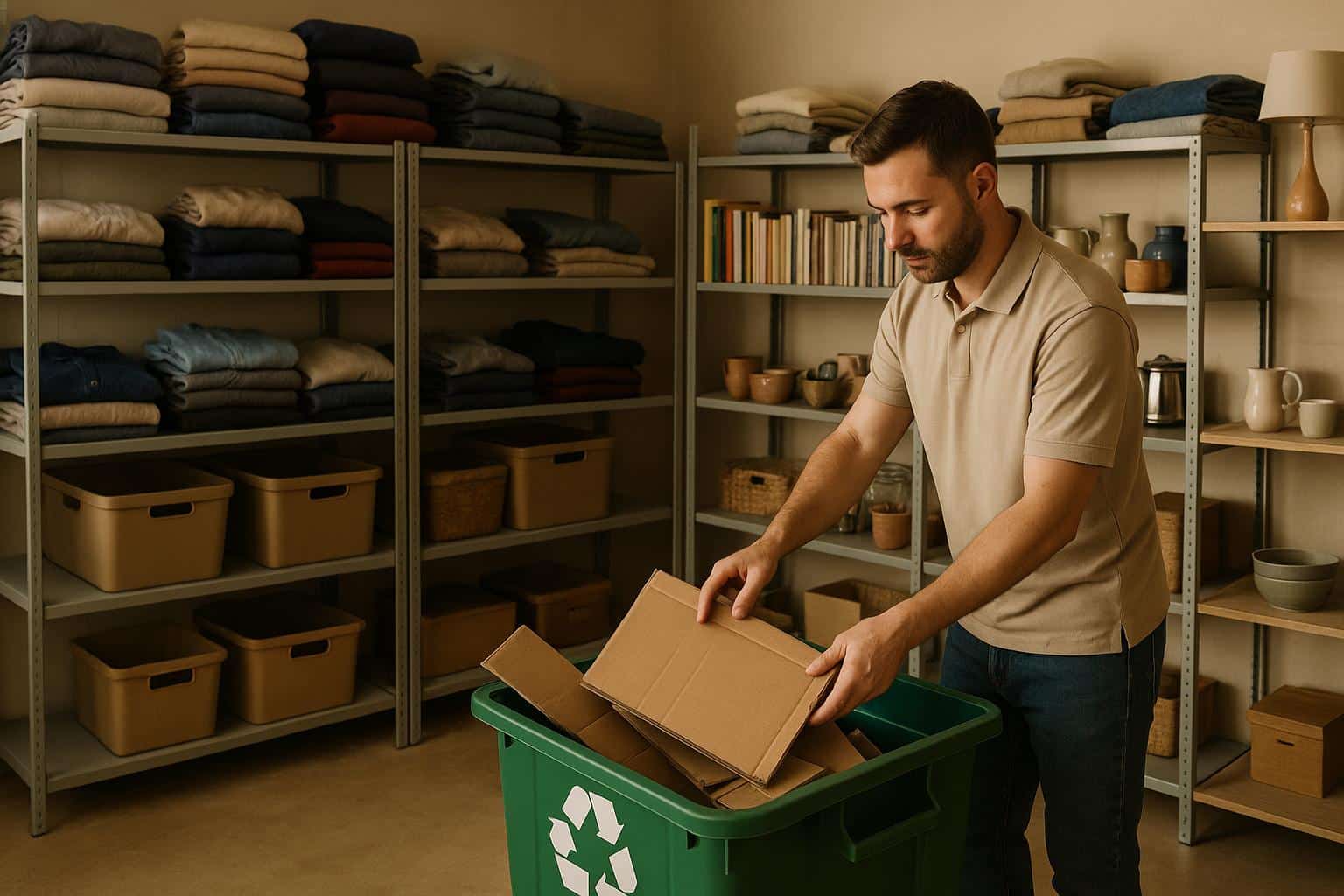
Spring cleaning is the perfect time to declutter your home while helping others and the environment. Here’s how to sort your belongings:
- Keep: Items you use often, need for specific seasons, or hold sentimental value.
- Donate: Gently used clothing, electronics, furniture, and more to organizations like Red Racks Thrift Stores, which support Disabled American Veterans.
- Recycle: Electronics, batteries, textiles, and other materials that can’t be donated through local recycling programs.
Quick Tip: If you haven’t used something in over a year, it might be time to let it go. By organizing your space, you can make a difference in your community and reduce waste.
Ready to dive in? Follow this guide to make your spring cleaning simple and impactful!
3 Simple Steps: Keep, Donate, or Recycle
Deciding what to do with your belongings doesn’t have to be overwhelming. Here’s a simple way to sort through your items and organize your space while helping others and the environment.
Items to Keep
First, figure out what’s worth keeping. Hold on to items that:
- You use regularly or need for specific seasons
- Carry sentimental value
- Are in good working condition
If something hasn’t been used in over a year, it might be time to let it go. Keep only the things that genuinely improve your daily life.
Items to Donate
Red Racks Thrift Stores accepts a range of items, with proceeds benefiting Disabled American Veterans. Before donating, make sure your items are:
- Clean and fully functional
- Free of major damage or stains
- Suitable for resale
"As the weather turns nicer and Michiganders are starting spring cleaning projects, we hope they’ll consider whether an item can be recycled or reused before they simply toss it in the trash. To kind of turn a phrase, ‘What’s old can often become new again.’" – Tracy Purrenhage, recycling specialist for the Michigan Department of Environment, Great Lakes, and Energy (EGLE)
Here’s a quick guide for what’s accepted:
| Accepted Donations | Not Accepted |
|---|---|
| Flatscreen TVs (2 years old or newer) | Tube TVs |
| Furniture in good condition | Damaged or stained furniture |
| Clothing and accessories | Items with mold or mildew |
| Working electronics | Baby cribs or car seats |
| Books and media | Encyclopedias or magazines |
| Home decor | Items containing chemicals |
| Sports equipment | Large appliances |
If an item isn’t donation-ready, consider recycling it instead.
Items to Recycle
For items that don’t qualify for donation, recycling is the next best option. Here’s how to handle common items:
- Electronics: Drop them off at designated recycling centers.
- Containers: Make sure they’re rinsed and empty before recycling.
- Batteries: Take them to specific collection sites – don’t toss them in curbside bins.
- Textiles: Repurpose old fabrics as cleaning rags.
"We also urge people to check with their local recycling service to learn exactly what materials they accept." – Tracy Purrenhage, recycling specialist for the Michigan Department of Environment, Great Lakes, and Energy (EGLE)
When in doubt, check with your local recycling service to confirm what’s accepted. If you’re still unsure, it’s safer to dispose of the item in regular trash.
Room-by-Room Sorting Guide
Tackle spring cleaning one room at a time to make decluttering more manageable.
Clothes and Accessories
Take everything out of your closet and dresser, then sort items into three categories: keep, donate, or recycle. Keep seasonal clothes you’ve worn recently and formal wear that still fits your style.
Focus on these areas:
- Shoes: Inspect for wear and damage.
- Accessories: Go through jewelry, belts, and bags.
- Athletic wear: Check for proper fit and condition.
- Seasonal items: Review winter coats, summer outfits, and similar items.
If an item has minor issues, like a missing button or a broken zipper, it can still be donated! Red Racks partners with vendors who repurpose such items to help communities in need. Once your clothes and accessories are sorted, apply the same approach to larger household items.
Home Items and Furniture
Start with big pieces and work your way down to smaller ones. Keep only what’s in good shape and serves a purpose.
| Room | Items to Check | What to Look For |
|---|---|---|
| Kitchen | Appliances, cookware | Functionality, how often it’s used |
| Living Room | Furniture, decor | Stability, relevance to your style |
| Dining Room | Tables, chairs | Sturdiness, surface condition |
| Bedroom | Bed frames, dressers | Drawer functionality, sturdiness |
In the kitchen, check for duplicate items and make sure containers have matching lids. When donating furniture, ensure it’s stable and doesn’t have major damage.
Electronic Devices
Electronics require careful sorting since they often need special disposal methods. Donate items like:
- Flatscreen TVs (less than 2 years old).
- Small appliances that are still functional.
- Exercise equipment (no older than 10 years).
For electronics that can’t be donated, check for local drop-off centers or special collection events. Many electronics retailers also offer e-waste recycling options.
Books and Media Items
Go through your books, CDs, DVDs, and other media. Decide what to keep based on sentimental value, practicality, or whether you have duplicates.
When donating, double-check that media cases contain the correct discs. Red Racks accepts most books but doesn’t take encyclopedias or magazines. For items that aren’t suitable for donation, look into local recycling programs that handle paper products and plastic cases separately.
Donation Guidelines
How to Prepare Donations
Before donating, take a moment to check each item. Clean items are more likely to sell and directly help support disabled veterans.
For clothing:
- Wash thoroughly to ensure garments are fresh.
- Check for minor flaws like missing buttons or small tears.
- Fold items neatly for easier handling.
- Group similar items together, such as separating shirts, pants, and jackets.
For household items:
- Test electronics to confirm they work properly.
- Clean and organize components (e.g., cords, attachments).
- Remove personal information from any devices or items.
After preparation, double-check that your donations meet the criteria set by Red Racks.
Red Racks Donation Rules
Stick to these rules to ensure your donations help Disabled American Veterans effectively:
| Category | Accepted Items | Requirements |
|---|---|---|
| Electronics | Flatscreen TVs | Must be under 2 years old and working |
| Exercise Equipment | Ellipticals, Treadmills, Exercise Bikes | 10 years old or newer |
| Medical Equipment | Crutches, Walkers, Shower Chairs | Clean and fully functional |
| Household Items | Small Appliances, Home Décor | Must be clean and in working order |
| Outdoor Items | BBQ Grills | No propane tanks; no visible damage |
Items Not Accepted:
- Anything with mold or mildew
- Mattresses and bed pillows
- Baby cribs and car seats
- Tube TVs
- Building materials
- Encyclopedias or magazines
- Food items
For furniture donations, ensure pieces are clean, free from stains, odors, structural damage, or tears. Red Racks even accepts clothing with minor flaws through vendor partnerships. If you’re unsure about a specific item, reach out to your local Red Racks store for guidance.
sbb-itb-ad405ba
Recycling Guide
When donating isn’t an option, recycling is the next best step to reduce waste. It helps cut down on landfill use and supports resource conservation.
Local Recycling Options
Earth911.com offers a database with details on over 350 materials and more than 100,000 recycling locations. Use it to find facilities for items like:
- Electronics: Requires special handling and shouldn’t go in regular recycling bins.
- Hazardous Materials: Items like batteries and paint need specific disposal methods.
- Construction Materials: Facilities exist to handle renovation debris.
- Automotive Items: Includes parts and fluids that need specialized processing.
Before heading out, check each facility’s hours, accepted items, fees, and specific procedures.
How to Sort Recyclables
Once you’ve identified a recycling facility, sorting your items properly is key. Use the table below as a guide:
| Material Type | Preparation Steps | Common Mistakes to Avoid |
|---|---|---|
| Containers | Rinse clean, remove caps | Leaving food residue |
| Paper/Cardboard | Keep dry, flatten boxes | Adding greasy pizza boxes |
| Glass | Rinse, remove metal caps | Breaking items |
| Electronics | Remove batteries, wipe data | Mixing with regular recycling |
Additional tips for recycling:
- Make sure food and liquids are never placed in recycling bins.
- Do not include loose plastic bags – they can jam recycling machinery.
- Remove and discard greasy portions of pizza boxes.
- Keep a recycling guide handy near your sorting area for quick reference.
For items made from mixed materials, look for specialized recycling services or think about creative reuse options. Scrap metal, for instance, often needs to be dropped off at specific facilities instead of being left out for curbside collection.
Recycling rules can vary by location, so always check your local guidelines. This ensures your efforts are effective and help maximize the use of recyclable materials.
Community Benefits
When you donate during spring cleaning, you’re directly supporting Red Racks Thrift Stores, which are owned and operated by Disabled American Veterans. Here’s how your contributions make a difference for veterans and the community:
- Direct Support for Veterans
Your donations help fund:- Transportation services and medical equipment for VA facilities
- Department Service Officers who assist veterans with claims
- Programs focused on rehabilitation and housing to combat veteran homelessness
- Strengthening the Local Community
Red Racks backs important local programs like Meals on Wheels, the American Cancer Society, Elizabeth Hospice, and VA Hospital support. These initiatives improve community wellbeing and create a stronger support network. - Reducing Waste and Creating Jobs
Items that can’t be sold are repurposed through vendor partnerships. This not only reduces waste but also helps create jobs locally.
Your donations have a far-reaching impact. Proceeds support Department Service Officers who play a key role in helping disabled veterans navigate the claims process. For assistance, reach out to these officers at 619-299-6916.
Conclusion
Spring cleaning can do more than just tidy up your home – it can make a real difference in your community. Using the three-box method – Keep, Donate, Recycle – offers an easy way to declutter while giving back.
When you choose to donate to Red Racks Thrift Stores, you’re directly supporting programs for veterans. These donations fund services like nearly 615,000 rides for veterans and help secure over $4 billion in benefits. As Doug DePew, CEO, puts it:
"It’s not every day when cleaning your home can provide so much help to the local community".
Before you finish your cleaning, remember to clean and sort items properly. Every step you take helps ensure your contributions are ready to support veteran services.





